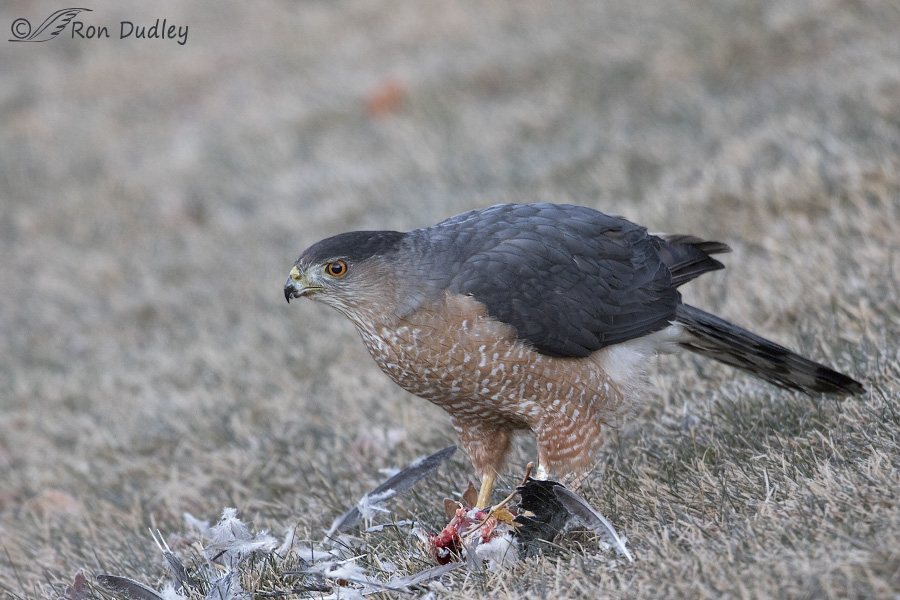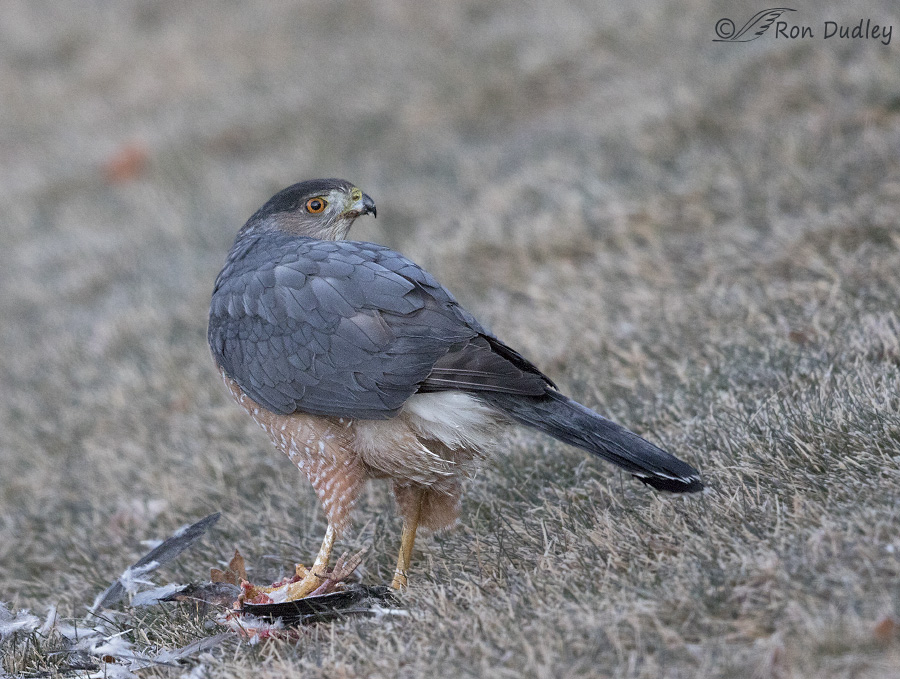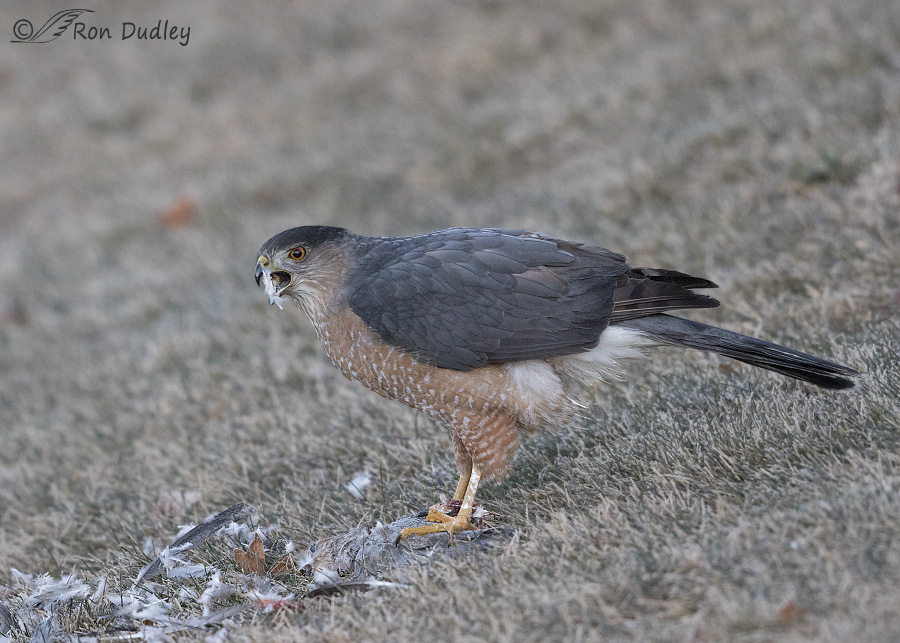Yesterday’s photo excursion started out with a bang.
As per usual I left the house while it was still mostly dark so I could be on site soon after sunrise. Depending on my destination it takes me 40 minutes to an hour to get there so that means an early departure and a fairly long drive fortified by coffee, good conversation and my extended waking up process. But yesterday morning I was greeted by a serendipitous event right at the get-go.

1/80, f/6.3, ISO 1600, Canon 7D Mark II, Canon EF 500mm f/4L IS II USM + 1.4 tc, not baited, set up or called in
I had barely left my driveway when we found this Cooper’s Hawk (possibly a Sharp-shinned, if so please correct me) on a neighbor’s lawn. It was eating a Mourning Dove so it had no intention of flying off even as other vehicles passed by within just a few feet of it. I suspect the near-darkness gave it some bravado. I simply pulled over to the curb and began to photograph it from my pickup at a distance that wouldn’t make it nervous.
The shooting conditions were atrocious in the near darkness. The hawk was actively feeding which made it virtually impossible to get sharp images at this shutter speed so about all I could do was “spray and pray” by firing off a bunch of shots and hope that some were relatively sharp.

1/320, f/4.5, ISO 2000, Canon 7D Mark II, Canon EF 500mm f/4L IS II USM + 1.4 tc, not baited, set up or called in
The posture of the bird in this shot might suggest that it was nervous and about to take off but that’s just not the case. It had simply turned on its prey to get a better feeding angle and looked over its shoulder in my direction very briefly. It continued to feed with gusto.
These images were all moderately underexposed in camera because of a bad habit of mine (I have a few…). The way I evaluate exposure is by quickly reviewing an image or two on my camera screen for brightness. In most conditions that method works well for me because I’ve had a lot of practice at it. But when light is very low I tend to underexpose because in the darkness my screen looks brighter than it really is and that’s exactly what happened here.
I simply have to learn to accurately use the histogram to evaluate exposure but being a creature of habit I find it difficult to change my ways. Hopefully my session with this hawk will give me the motivation I need because underexposing the images that already had a higher noise level due to my ISO setting meant that noise was increased even further when I bumped up exposure during processing.

1/320, f/5, ISO 2000, Canon 7D Mark II, Canon EF 500mm f/4L IS II USM + 1.4 tc, not baited, set up or called in
Here the hawk is struggling to get a sticky feather off of its wet beak so I was pleasantly surprised that the shot was sharp at this shutter speed. Many similar images were not.
After spending a few minutes with this bird we left it to go to Antelope Island but I’d forgotten to check something in my house so I quickly went home first (two houses away) and then drove by the hawk again as I left. It was still there feeding on the dove in the darkness as I drove past.
This clip shows the hawk as it was feeding on the dove (don’t worry, it isn’t gory). The sounds you hear in the background are traffic noise from a nearby freeway and shutter clicks. It was much darker than it looks like it was in the clip. Some of my clips in the past have been of very poor quality but I’ve finally figured out how to upload them to YouTube at a higher resolution so this one is noticeably better, even in the very poor light.
My video skills need improvement but I’m working on them…
Ron
Note: Photographers may be interested in this article titled “Noise? Get Over It And Use High ISO’s“. It reinforces my own opinion on the subject.


Beautiful adult Cooper’s hawk! It is usually a male that has the vibrant blue-gray mantle of this bird. Females tend to a browner shade.
Thanks Ron. I echo Culley’s comments. Amazing to watch those “awesome city predators ruthlessly culling the weak and inattentive ” (paraphrased from John Haverson in Black Hills) in our backyard. Our resident pair fledged 4 last year. Your photos are very special t.o me as coops got me into raptor volunteering
Great shots, Ron (as usual). I think that’s a Cooper’s, but it’s hard to tell for me. But it’s got the rounded tail. It’s also an adult with those lovely orange eyes. You stumbled on an unusual site–they’re usually MUCH more secretive in their appearances, but a good breakfast is a good thing…LOL! Love it that you took advantage of that opportunity. I’d just be sitting there with my mouth hanging open. I remember the first time I held a Cooper’s hawk on my fist–I was completely and utterly overwhelmed by what I can only describe as the quality of gray in her feathers. It’s nothing like the skies in my world. Instead, the Cooper’s hawk gray is alive and vibrant, shimmery as it glistens in the light. I gawked each time she flew to me. Another one of those times when my jaw rested on the ground. THANKS for these images.
Laura, I think I’ve seen the quality of those gray feather that you describe but only briefly. In this light I was lucky to see the bird at all…
Fabulous shots Ron! “Stop in your tracks” shots! Am I seeing iridescence in the blue-gray feathers?
“Am I seeing iridescence in the blue-gray feathers?”
Nancy, I’m no expert but I doubt it. I suspect it’s an effect of the low light on those dark feathers.
It’s not irridescence as we know it, but more of a shimmery glisten…I call it a quality of gray. I can’t thing of any other way to describe it.
Good Work, Ron.
I have had Sharpies come within 3 feet of me twice, over the years, pursuing the local sparrows around my domicile. I think they are pretty brash critters.
These are nice images Ron given the conditions. I like the second image the best since it shows the beautiful patterns on the top feathers of the accipiter.
I was starting to write a dissertation on sensor physics and noise and then decided that it would be better to just compare notes in person some day while photographing birds together 🙂
Thanks, Ed. I’d be interested in that dissertation if we ever manage to get together…
A great way to start off your morning! (And now mine too, it seems) It looks like a Coop to me but a female sharpie can and will hunt prey as large as doves and pigeons. Even little American kestrels have been known to take dove, quail, and pigeon if the opportunity presents itself
Whoa!, I had no idea that a kestrel could take a dove or pigeon. That’s impressive. Thank you, Mark.
Ron and Mark, the diminutive thing is merely an optical illusion with Kestrels…LOL!
I agree. Their attitude and grip strength would support that theory. Once they bind on to something, they hang on with great determination, sometimes going for a ride on the back of a rock dove/pigeon until the quarry is forced to land. Many falconers in the U.K. love flying our little kestrels because of this.
Fantastic Ron!
Charlotte
Thanks, Charlotte.
Nice shots of a Cooper’s Hawk. The prey items gives it away. I had one take down a dove in my yard a few weeks ago but unlike this one it was nervous and took his catch somewhere more secure. My yard is in the territory of a pair of Red-Shouldered Hawks. They don’t take to kindly to other hawks.
Thanks, Drew. Good point about the size of the prey as an indicator for ID.
Looks like a Coopers to me…sturdier legs, length and shape of tail, how head and body join..interesting series…light looks OK to me…this bird has been “handed to you on a silver platter”… Sometimes your luck is as amazing as your photography!!!
Patty, Yes, I have amazing luck but on both ends of the spectrum – good and bad. The secret is to spend enough time in the field so that the number of positive encounters continues to grow. You just have to put up with the other kind…
Great shots Ron, thank you for sharing your find. I thought the pics were very nice and clean considering the light. The crop-body cameras struggle in low-light…I feel you there. I am in awe that you could shoot 80-320 at 1120mm and still come out with crisp shots. I gotta get me a pool noodle for my window.
Zaphir, those noodles are fantastic for lens rests but I’ll come clean about something. Finding this bird was so unexpected that I wasn’t prepared for it so my noodle was still in the back seat. For these shots my lens was just resting on the window glass which is something I REALLY don’t like to do.
Beautiful adult Accipiter. To me the hawk looks big, but I wasn’t there and camera angles can be deceiving. Sharp-shinned are supposed to have a short tail, with the end squared off, thin legs and a small head compared to a Cooper’s Hawk. Cooper’s should have a strong contrast between the top of the head and the back, plus being larger than a Sharpie. All my run-ins with Cooper’s is that they are feisty, won’t budge off of prey if they can get away with it and almost dare you to come close. I would say based on where you were, the fact that there was a freeway close by and the attitude of this hawk I would agree it is a Cooper’s. If, for no other reason than his/her arrogance at feeding in front of you. Just my take on what is shown.
I’m not sure a brighter picture would be any better – I think these images are fantastic!!
Dick, I brightened these images during processing. They were significantly darker (too dark) in camera.
From what you’ve said and the feedback I’ve had on FB I feel pretty confident that this bird is a Cooper’s. Thank you.
Outstanding!! The photos look great to me!!!
Thank you, Gail.
Really enjoyed this. I love that he or she was not going anywhere. And, I’m a little happy it got a dove. LOL
Thanks, Arwen. I’d have been happier if it had been a Eurasian Collared Dove…
HEAR HEAR! Sigh. We have those here and they are just a pain in the butt. They knocked one of my feeders down yesterday.
Good ID. Nice Cooper’s! Nice images too!
Thanks very much, Gail.
Good shots with plenty of detail even with a little noise. 🙂 Pretty bird for sure. Glad it was hungry enough to hang in there! 🙂 I also get antsy about upping the ISO tho working on it. 🙂
Judy, Noise is such a finicky thing with so many variables, including color of the background (darks make it more noticeable) and noise handling capabilities of the camera. I’ve learned to tolerate some noise, especially when the only options are sharp somewhat noisy images or soft, clean shots. I much prefer the former.